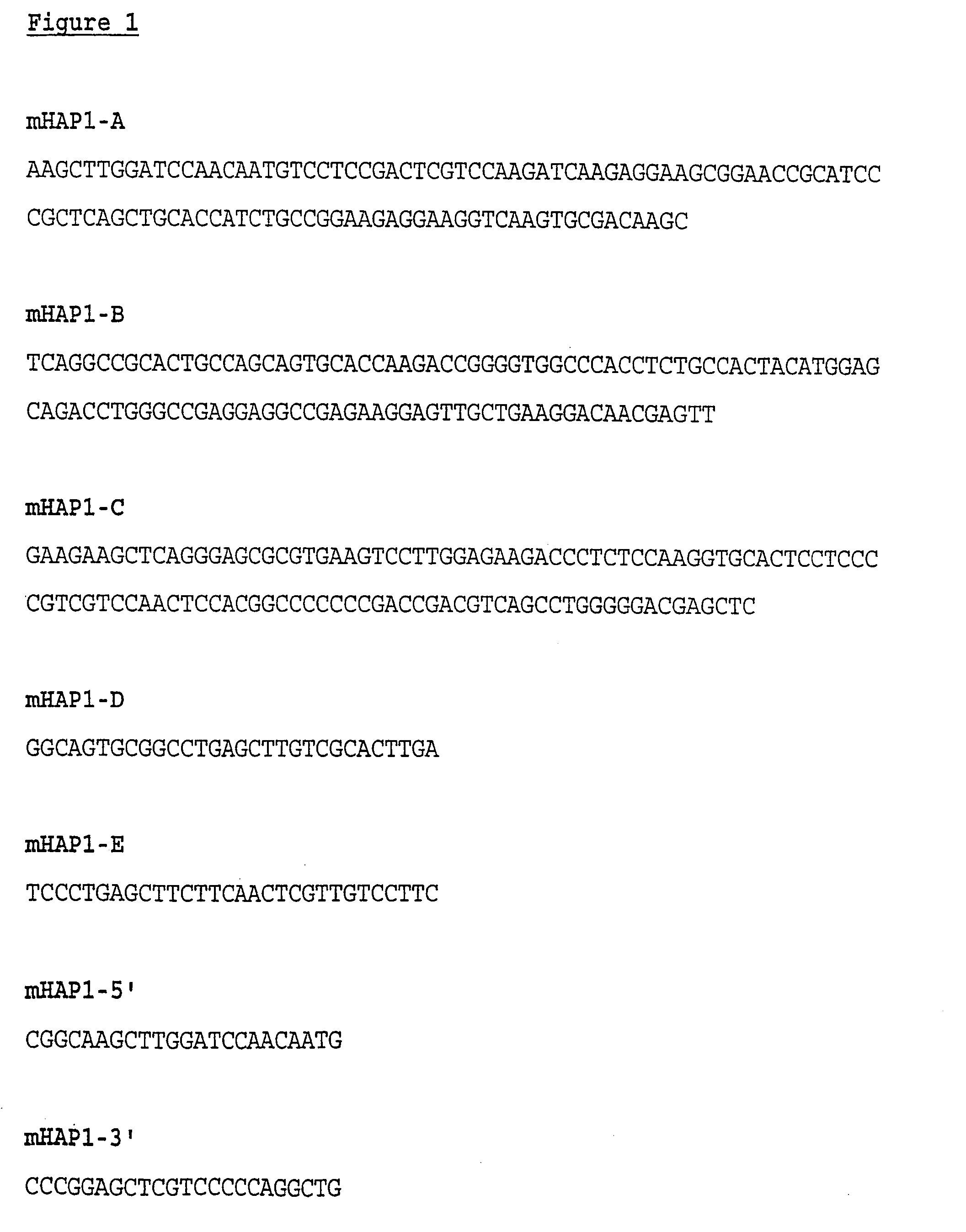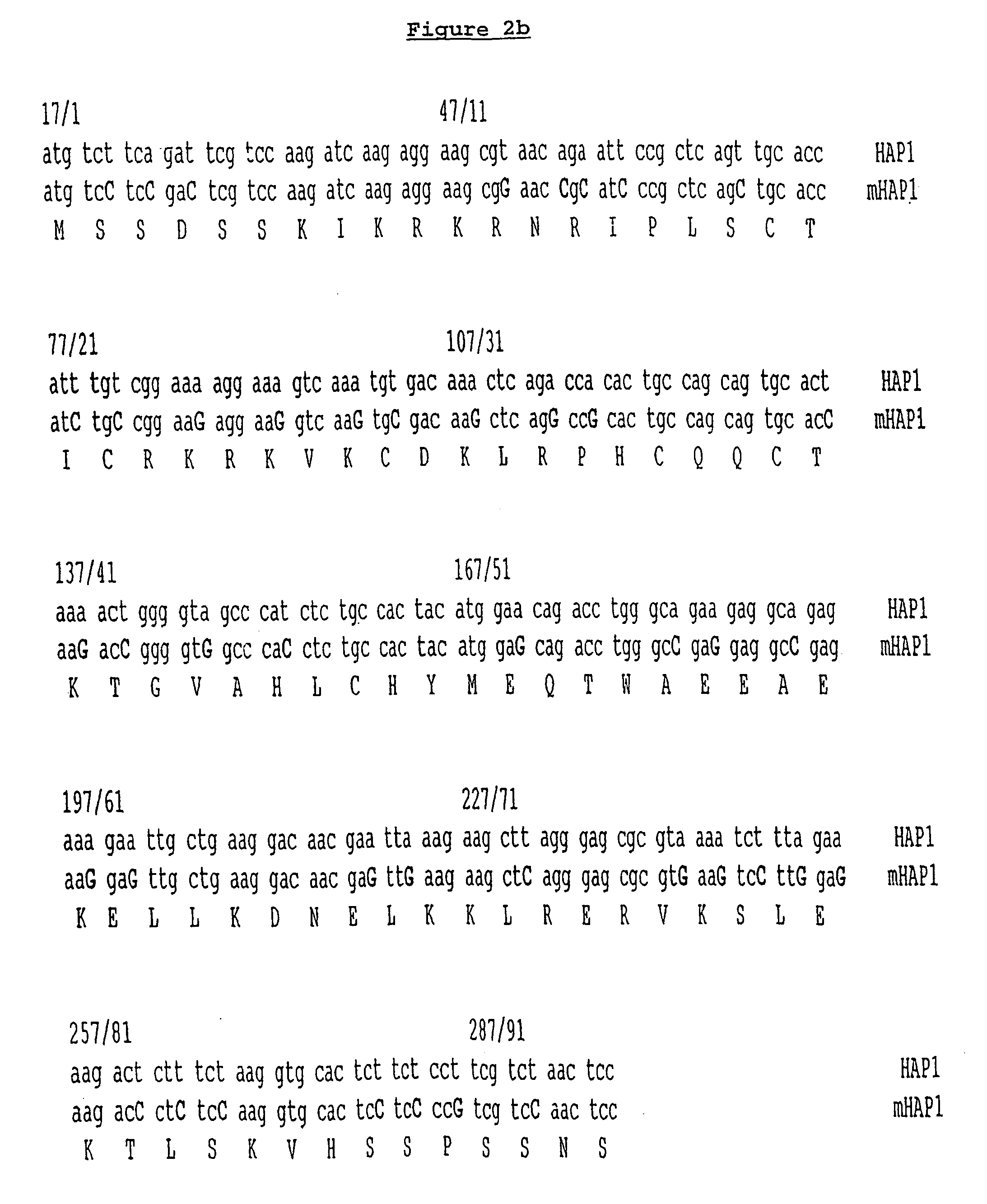Gene expression construct
a gene expression and construct technology, applied in chemical libraries, plant cells, enzymes, etc., can solve the problems of limiting the usefulness of reporter proteins such as gfp, unable to allow and unable to achieve the activation of different genes in different cell types and/or at different times within the same plan
- Summary
- Abstract
- Description
- Claims
- Application Information
AI Technical Summary
Benefits of technology
Problems solved by technology
Method used
Image
Examples
example 1
Construction of the Modified HAP1-VP16 Gene
[0098] The yeast HAP1 protein is a member of a family of zinc-finger (Cys4) transcription factors which are limited to fungi, and homologues have not been found in plants to date. Yeast genes have a high A / T content and are often poorly expressed in Arabidopsis due to aberrant post-transcriptional processing. A synthetic gene which has an elevated G / C content, and in which the DNA binding domain is fused to the highly active and G / C-rich transcription activator domain of VP16, was constructed:
[0099] Three long oligonucleotides, mHAP1-A, B & C (shown in FIG. 1) were made using automated synthesis on solid supports. The oligonucleotides encoded the predicted DNA binding domain of HAP1 protein with modified codon usage. Codon usage was modified according to the following criteria: [0100] (i) GC content was increased [0101] (ii) splice junction consensus sequences were avoided [0102] (iii) the resultant amino acid sequence encoded by the nucl...
example 2
Construction of Insoluble GFP Marker
[0106] A variant of GFP was fused to the coding sequence of a carrot extensin. PCR amplification was used to obtain a copy of the extensin gene, isolated from carrots purchased in Cambridge market square. The carrot gene was genetically fused to a variant of green fluorescent protein obtained from Packard Biosciences (Meridian, Conn. (GFPemd).
[0107] A schematic diagram of the extensin-GFP gene fusion is shown in FIG. 3a with the coding sequence shown in FIG. 3b (top line), the encoded amino acid sequence is shown below in the bottom line of FIG. 3b. Extensin sequence is in lower case and GFP sequence is in uppercase.
example 3
Expression of Extensin GFP Gene Fusion in Transgenic Arabidopsis
a) Construction of the 35S-Extensin-GFP Construct.
[0108] A variant of GFP was fused to the coding sequence of a carrot extensin. PCR amplification was used to obtain a copy of the gene, isolated from carrots purchased in Cambridge market square. The carrot gene was genetically fused to a variant of green fluorescent protein obtained from Packard Bioscience (GFPemd (emerald)). Expression of this gene fusion in transgenic Arabidopsis tissues results in the decoration of cell walls with bright fluorescence.
Construction of the GFP-Extensin Gene
[0109] The following oligonucleotides were synthesised, and used as primers for the PCR amplification of the carrot extensin gene.
CarExt5GGC GGA TCC AAC AAT GGG AAG AAT TGC TAG AGG CTCCarExt3GGC GGA TTC GTA GTG GTG AGG AGG AGG AGG TGA CGT
[0110] Template carrot DNA was isolated using a Qiagen DNA extraction kit (UK—QIAGEN Ltd., Boundary Court, Gatwick Road, Crawley, West Sussex...
PUM
| Property | Measurement | Unit |
|---|---|---|
| nucleic acid | aaaaa | aaaaa |
| multispectral dynamic imaging | aaaaa | aaaaa |
| nucleic acid sequence | aaaaa | aaaaa |
Abstract
Description
Claims
Application Information
 Login to View More
Login to View More - R&D
- Intellectual Property
- Life Sciences
- Materials
- Tech Scout
- Unparalleled Data Quality
- Higher Quality Content
- 60% Fewer Hallucinations
Browse by: Latest US Patents, China's latest patents, Technical Efficacy Thesaurus, Application Domain, Technology Topic, Popular Technical Reports.
© 2025 PatSnap. All rights reserved.Legal|Privacy policy|Modern Slavery Act Transparency Statement|Sitemap|About US| Contact US: help@patsnap.com



